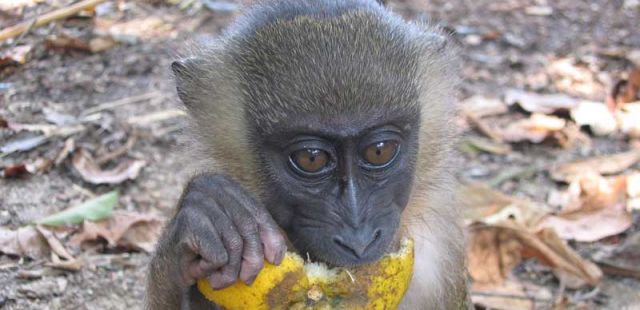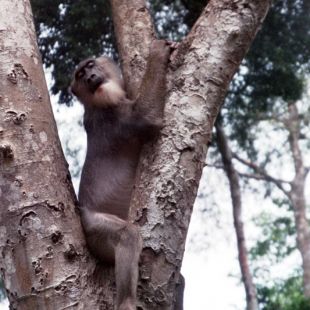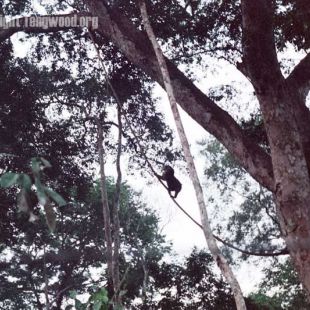Habitat and Diet
Both drills and mandrills are wary of human observers and have remained elusive to study. Very little is really known about their lives in the forest, so bits and pieces have been put together by the various scientists studying these primates. Drills live in dense, primary forest and most of a drill group's day is likely spent traveling in search of food and they are known to have very large, seasonal home ranges (traveling up to 5 square kilometers a day). In the wild, most primates, including drills, spend the majority of their time just finding enough to eat. Overall, the forest is not an easy place to live - imagine searching the forest for food with a large, hungry group of people who are searching in the same place. It is a delicate balance between the safety of the social group and finding enough to eat.
The preferred food of the drill is forest fruits - when they can find them! The majority of the diet will be fruit when it is in season, but the distribution of fruiting trees is patchy and drills must know where to go and when fruits are in season. During the dry season, or times when fruit is scarce, drills must supplement their diet with other foods, such as young leaves and grasses, and the pith of tree branches. Most of a drill's time is spent foraging in the leaf litter. Here, drills find insects, which provide protein, and also seeds, which their hard molar teeth are thought to be specially designed to crack open. In fact, drills, mandrills, and mangabeys are believed to be 'seed specialists' (see Fleagle and McGraw's work on the specialized dental morphology of Mandrillus). Seeds last for long periods of time on the forest floor and are also high in protein. Primates that eat fruits and seeds, such as the drill and chimpanzee, play an important role in maintaining the forest via seed dispersal.
During travel, drills spend a large proportion of their time on the ground, resulting in reports that drills are 'terrestrial'. In truth, drills are very good climbers. Drills and mandrills have specialized forearm muscles and can cling vertically and leap long distances from tree to tree (see this video of mandrill locomotion in trees). They also spend their nights very high in the trees - a drill sleeps most comfortably about 100 feet up and balancing on a precarious branch! Drills sleep this way to avoid predators. In the morning, the group climbs down and travels on their daily food foray. The day also includes some rest stops, where the majority of socializing occurs. Captive drill groups living in natural forest enclosures in Nigeria were observed to socialize mostly at the beginning (dawn) and end (dusk) of their day, usually around the sleeping tree.


























